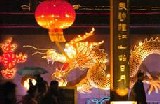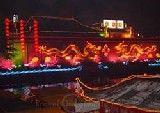Nanjing Major Events & Festivals
Based on the dates in the Chinese Lunar Calendar, many traditional
festivals and customs are celebrated in Nanjing, including the
climbing of City Wall on January 16, bathing in Qing Xi on March
3, hill hiking on September 9, and others.But sadly many of
such festivals are no longer really celebrated by the more modern
Nanjing people.
Instead, Nanjing, as a popular tourist destination, hosts a
series of government organized events throughout the year.The
annual International Plum Blossom Festival held in Plum Hill,
the largest plum collection in China, attracts thousands of tourists
both domestically and internationally.Other events include
Nanjing Baima Peach Blossom and Kite Festival, Jiangxin Zhou
Fruit Festival, and Linggu Temple Sweet Osmanthus Festival.
 The
Jinling Festival also is called the lantern festival day or the
lantern festival.It was said that the first lantern fair was
held in this region in the reign of Hong Wu in the Ming Dynasty
(1368 - 1644), when Emperor Zhu Yuanzhang ordered a spring lantern
fair to be held to celebrate both the coming New Year and prosperity
of the country. This tradition was passed down from generation
to generation and reached its height in the Ming and Qing periods. The
Jinling Festival also is called the lantern festival day or the
lantern festival.It was said that the first lantern fair was
held in this region in the reign of Hong Wu in the Ming Dynasty
(1368 - 1644), when Emperor Zhu Yuanzhang ordered a spring lantern
fair to be held to celebrate both the coming New Year and prosperity
of the country. This tradition was passed down from generation
to generation and reached its height in the Ming and Qing periods.
Each year from the first day of the lunar January
the lantern fair celebration is held in the area surrounding
Fuzimiao and the lantern festival lasts 10 days and on the eighth
day of the Chinese New Year, people light a lantern and close
up their shops at 6:00 pm
| The Plum Blossom Festival |
One of Nanjing's greatest folk holidays is the
Plum Blossom Festival, which is held every year in late February
or early March on Plum Hill. Plum Hill is reputed as the "First
Plum Hill under Heaven" for it is one of the eight plum appreciation
sights having the most variety, longest history, and one of the
largest in China.
On the day of the Plum Blossom Festival, it is
said that the Nanjing people are the happiest.On the eastern
suburb lies the Plum Blossom Mountain. When the several thousand
plum are in complete bloom, tens of thousands of Nanjing people
walk up the plum blossom mountain to view the flowers and look
at the scenery.
During the Plum Blossom Festival spectacular celebrations
of blossom appreciation, show performances, cultural exhibitions
and bazaar shopping are also held.
| Climb to the Top of the City Wall Festival |
The climb to the top of the city wall takes place
in the first lunar month on the 16th.This day Nanjing people
all must enter the city with a family member or some good friends
to visit scenic sites every year.The purpose of doing this
is "to ward off bad luck and tread peace".
| Other Festivals in Nanjing |
 Cherry
Blossom Festival Cherry
Blossom Festival
In late March, Xuanwu Park becomes a sea of cherry blossom and
photography lovers and tourists throng to see the charming scenery.
Yuhuashi (Rain Flower Pebbles) Art Festival
Yuhuashi, a kind of rain flower pattern agate, is a very popular
tourist souvenir.Each year in September, an art and cultural
festival is held in Yuhuatai (Rain Flower Terrance) Scenic Area.Exhibition of precious agate stones and performances will be
presented.
Flower Festival
Autumn is a blossom season in Nanjing when parks
and gardens will hold flower festivals.For example, from September
to November, a 300 meter long road in the Lingu Park will become
a charming flower street with scented flowers along its length.
Maples on Mount Qixia are amazing.
Hunan Road Annual
Flavored Food Festival
Located in the northwestern part of the city in Drum Tower District
(Gulou District), this one kilometers long street is one of the
most prosperous shopping streets in Nanjing with the famous Shiziqiao
Food Street in the middle. The street is always bustling with
people and makes for an interesting evening with friends. An
annual flavored food festival is held here to attract tourists.
This walking street is filled with dozens of restaurants
providing both Chinese and western style foods. The street is
divided into three parts. The first part has restaurants providing
typical local cuisine, among which Shiwangfu Restaurant is the
best. The second part is known as the Chinese Food Street where
various cuisines from different parts of China are found. The
third part is the area which has food from Japan, Korea, India,
Thailand and the west.
|